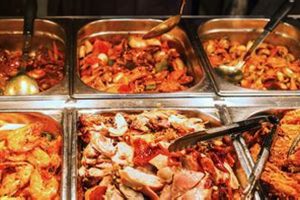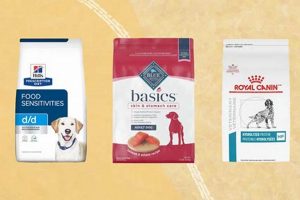The selection of hand coverings intended for culinary tasks represents a critical decision for food service professionals and home cooks alike. These barriers serve as a protective layer between bare skin and ingredients, mitigating the risk of cross-contamination and promoting adherence to hygiene standards. The suitability of such items hinges on material composition, durability, and intended application. For example, single-use nitrile variations are commonly favored for their resistance to oils and fats, while reusable options made from materials like silicone offer enhanced longevity and heat resistance.
Employing appropriate hand protection in food handling yields numerous advantages. It significantly reduces the transmission of pathogens, fostering a safer environment for consumers and kitchen staff. Furthermore, it protects the wearer from harsh chemicals, extreme temperatures, and potential allergens present in certain foodstuffs. Historically, the adoption of these preventative measures has been instrumental in diminishing the incidence of foodborne illnesses and elevating overall food safety protocols within commercial and domestic settings.
The subsequent discussion will delve into the key factors to consider when selecting appropriate hand coverings for food preparation, including material properties, sizing considerations, and specific use cases. It will also explore various available types and their relative strengths and weaknesses, providing a comprehensive guide for informed decision-making.
Selection and Use Guidance
The following guidelines offer practical advice for maximizing the effectiveness of hand protection in culinary environments.
Tip 1: Material Appropriateness: Prioritize material selection based on the specific food being handled. Nitrile variants are well-suited for handling fatty foods due to their resistance to degradation, while latex may pose allergen concerns for certain individuals.
Tip 2: Proper Sizing: Ensure a snug yet comfortable fit. Overly large coverings can impede dexterity and increase the risk of slippage, while excessively tight options can compromise circulation and reduce tactile sensitivity.
Tip 3: Single-Use Protocol: Adhere strictly to single-use guidelines for disposable options. Reuse introduces the potential for cross-contamination and negates the intended hygienic barrier.
Tip 4: Inspection Before Use: Conduct a thorough visual inspection prior to donning. Discard any covering exhibiting tears, punctures, or other signs of damage.
Tip 5: Hand Hygiene: Practice diligent handwashing both before and after utilization. Handwashing serves as a crucial complement to external hand protection, further minimizing the risk of pathogen transmission.
Tip 6: Allergen Awareness: Be mindful of potential allergens, such as latex, and select hypoallergenic alternatives when necessary to accommodate sensitive individuals.
Tip 7: Task-Specific Selection: Match the choice of hand covering to the specific culinary task. Heat-resistant options are recommended for handling hot items, while cut-resistant variants offer enhanced protection during knife work.
Proper selection and usage contribute significantly to maintaining food safety standards and preventing the spread of contaminants in food preparation settings.
The subsequent section will address the importance of proper disposal techniques and explore emerging innovations in hand protection technology.
1. Material Composition
The efficacy of hand coverings in culinary settings is intrinsically linked to their material composition. Different polymers exhibit varying degrees of resistance to oils, fats, and chemicals commonly encountered during food preparation. Selecting an inappropriate material can compromise the barrier function, leading to cross-contamination and potential degradation of the glove itself. For instance, latex, while offering excellent tactile sensitivity, degrades rapidly upon contact with many cooking oils, diminishing its protective capability and potentially introducing latex allergens into the food. In contrast, nitrile exhibits superior resistance to these substances, making it a more suitable choice for handling a wide range of foodstuffs. Vinyl presents a cost-effective alternative for certain applications but offers less durability and puncture resistance compared to nitrile or latex. Therefore, material selection directly impacts the level of protection and hygiene maintained during food preparation.
Consider the specific scenario of handling raw poultry. The potential for Salmonella contamination necessitates a robust barrier. Nitrile, due to its superior puncture resistance compared to vinyl, minimizes the risk of penetration by bone fragments or sharp edges, thus preventing direct contact with the handler’s skin. Conversely, in pastry preparation, where fine motor skills are paramount, the tactile sensitivity of latex (for those without allergies) or a thinner nitrile variant may be preferred. Furthermore, for individuals with latex allergies, the availability of synthetic alternatives like nitrile or vinyl ensures that hand protection can be implemented without posing a health risk. The rise in latex allergies has significantly impacted the demand for non-latex options, illustrating the practical importance of material choice.
In conclusion, material composition is not merely a specification but a critical determinant of the overall performance and suitability of hand coverings in food preparation. Careful consideration of chemical resistance, durability, allergen potential, and tactile sensitivity is paramount. The selection of appropriate polymers directly influences the prevention of cross-contamination, protection against chemical exposure, and maintenance of food safety standards. The evolving landscape of material science continues to offer innovations that further refine the characteristics and benefits of these essential tools.
2. Puncture Resistance
Puncture resistance, as it pertains to hand coverings utilized in food preparation, is a critical attribute directly influencing safety and hygiene standards. Compromised barrier integrity, resulting from punctures, introduces pathways for microorganisms and contaminants to transfer between the handler’s skin and the food product. This breach undermines the primary function of the glove, increasing the potential for foodborne illness outbreaks and compromising quality control. The selection of hand coverings with adequate puncture resistance is therefore paramount to maintaining a safe and sanitary food handling environment. For example, handling shellfish or poultry bones necessitates a higher level of puncture resistance compared to tasks involving softer ingredients.
Materials like nitrile exhibit superior puncture resistance compared to latex or vinyl, rendering them more suitable for tasks involving sharp implements or potentially hazardous food items. The measurement of puncture resistance, often quantified in terms of force required to penetrate the material, provides a benchmark for assessing the protective capabilities of different glove types. Furthermore, factors such as glove thickness and manufacturing processes contribute to the overall puncture resistance. Real-world scenarios, such as a butcher handling bones or a chef filleting fish, highlight the practical significance of this attribute. Choosing gloves with insufficient puncture resistance can lead to lacerations, exposing the handler to potential pathogens and contaminating the food product with blood and other bodily fluids.
In conclusion, puncture resistance represents a fundamental component of optimal hand coverings for food preparation. Insufficient puncture resistance negates the intended barrier function, compromising food safety protocols. By prioritizing materials and designs that offer enhanced protection against puncture hazards, food handlers can significantly reduce the risk of contamination and maintain a higher standard of hygiene. The understanding and application of puncture resistance principles are thus essential for effective risk management in culinary environments.
3. Allergen Potential
The inherent allergen potential of materials used in the manufacture of hand coverings directly influences their suitability for food preparation. The most notable allergen associated with hand coverings is latex, a natural rubber protein. Exposure to latex proteins, through skin contact or inhalation of airborne particles, can trigger allergic reactions in sensitized individuals, ranging from mild dermatitis to severe anaphylaxis. The presence of latex allergens in food preparation environments poses a cross-contamination risk, potentially affecting consumers with latex allergies. Therefore, evaluating the allergen potential of various materials is a crucial step in selecting the most appropriate hand coverings for culinary use.
The increasing prevalence of latex allergies has prompted a shift towards the adoption of synthetic alternatives, such as nitrile and vinyl, in food handling settings. Nitrile, a synthetic rubber copolymer, exhibits a low allergen potential and offers superior resistance to oils and chemicals compared to latex. Vinyl, a polyvinyl chloride polymer, represents another latex-free option, although it typically exhibits lower puncture resistance and elasticity. The selection of latex-free gloves mitigates the risk of allergic reactions in both food handlers and consumers, fostering a safer and more inclusive environment. Foodservice establishments are increasingly required to provide latex-free options to comply with health regulations and cater to individuals with sensitivities. For example, a bakery handling nut-free products would need to ensure all gloves, not just those in direct contact with the nut-free goods, are latex free to prevent cross-contamination by airborne latex proteins.
In summary, the allergen potential of hand covering materials represents a significant consideration in food preparation. Latex allergies pose a tangible risk, necessitating a transition towards synthetic alternatives like nitrile and vinyl. Proper assessment of allergen potential and adherence to appropriate material selection protocols are essential for minimizing cross-contamination risks and promoting a safe environment for both food handlers and consumers. The move towards latex-free options exemplifies the ongoing efforts to mitigate allergen exposure and improve food safety standards in culinary settings.
4. Proper Fit
The relationship between proper fit and hand coverings designated for food preparation is causal and significant. Improper fit directly impacts the effectiveness of the glove as a protective barrier and can increase the risk of contamination. A glove that is too large compromises dexterity, increasing the likelihood of accidental spills or mishandling of ingredients. Conversely, an overly tight glove can restrict circulation, leading to fatigue and potential tearing, thereby exposing the wearer and the food to potential contaminants. Consequently, achieving a proper fit is not merely a matter of comfort, but an integral component of effective food safety practices. For example, a chef preparing sushi requires precise movements; a poorly fitting glove would hinder their ability to create delicate pieces, potentially leading to inaccuracies and wasted product, as well as increasing the risk of contamination.
The selection process should involve consideration of various glove sizes and materials to accommodate the diversity of hand dimensions and individual preferences. Manufacturers often provide sizing charts to guide users in selecting the appropriate fit. Beyond size, the elasticity and texture of the glove material contribute to maintaining a secure grip and preventing slippage, even in wet or oily conditions. Consider a scenario where a baker is kneading dough; a properly fitted glove, with adequate grip, will allow for efficient and sanitary handling of the dough, preventing cross-contamination and ensuring a consistent product. Training programs for food handlers should emphasize the importance of proper glove fitting procedures to reinforce the link between hygiene and operational efficiency.
In conclusion, proper fit is an indispensable attribute of hand coverings used in food preparation. It directly influences dexterity, reduces the risk of contamination, and contributes to overall food safety. While material composition and puncture resistance are crucial considerations, the absence of a proper fit negates the benefits of these features. Ongoing education and adherence to standardized fitting procedures are essential for ensuring that hand coverings function as intended, safeguarding both food handlers and consumers. The emphasis on proper fit should be viewed as a non-negotiable element of food safety protocols.
5. Intended Use
The specific application for which hand coverings are designated directly dictates the optimal characteristics required for efficacy. Disregarding the intended use during selection compromises the protective function of the glove and increases the risk of contamination or injury. Therefore, a comprehensive understanding of the tasks involved is paramount to choosing appropriate hand coverings.
- General Food Handling vs. High-Heat Applications
For routine tasks such as salad preparation or sandwich assembly, standard nitrile or vinyl gloves provide adequate barrier protection. However, handling hot items necessitates coverings with heat-resistant properties to prevent burns and material degradation. Silicone variants, specifically designed for high-temperature applications, offer superior thermal insulation compared to standard disposable options. Inadequate heat resistance results in compromised glove integrity and potential skin damage.
- Raw Meat and Poultry Handling vs. Ready-to-Eat Foods
Raw meat and poultry present a higher risk of bacterial contamination, requiring gloves with enhanced puncture resistance and impermeability to prevent cross-contamination. Thicker nitrile gloves are typically preferred for these tasks. Conversely, when handling ready-to-eat foods, meticulous hygiene practices and adherence to single-use protocols are crucial to prevent the introduction of pathogens. In this case, thinner nitrile or vinyl gloves may suffice, provided that proper handwashing procedures are strictly followed.
- Dishwashing and Cleaning vs. Food Preparation
Dishwashing and cleaning operations involve exposure to harsh chemicals and hot water, necessitating gloves with chemical resistance and durability. Heavy-duty rubber or neoprene gloves provide adequate protection against these hazards. Utilizing standard food preparation gloves for dishwashing is inappropriate as they are not designed to withstand prolonged exposure to detergents and sanitizers, leading to degradation and potential skin irritation.
- Allergen-Free Preparation
Preparing food for individuals with allergies, such as peanuts or gluten, requires dedicated hand coverings to prevent cross-contamination. Color-coded gloves, reserved exclusively for allergen-free preparation areas, minimize the risk of accidental exposure. Standard gloves, used for general food handling, should never be used for allergen-free preparation to avoid potential cross-contamination incidents.
The examples delineated above underscore the importance of aligning hand covering selection with the specific tasks at hand. A one-size-fits-all approach is inadequate for maintaining optimal hygiene and safety in food preparation environments. A nuanced understanding of the intended use allows for informed decision-making, leading to enhanced protection and a reduced risk of contamination or injury. Effective risk management hinges on the careful assessment of these factors, contributing to a more secure and hygienic food preparation process.
Frequently Asked Questions
The following addresses common inquiries regarding the selection and utilization of hand coverings in food preparation to promote informed decision-making and enhance food safety practices.
Question 1: What constitutes the most suitable material for hand coverings in a culinary environment?
The optimal material depends on the specific application. Nitrile is generally favored for its oil and chemical resistance, while latex (for non-allergy sufferers) offers tactile sensitivity. Vinyl presents a cost-effective, albeit less durable, alternative.
Question 2: How frequently should disposable hand coverings be replaced during food preparation?
Disposable hand coverings are intended for single use only. Replacement is mandatory after each task, after any interruption, or if the glove is compromised (e.g., torn, punctured).
Question 3: Is handwashing still necessary when utilizing hand coverings?
Yes, meticulous handwashing with soap and water is mandatory both before donning and after removing hand coverings. Hand coverings serve as an additional layer of protection, not a replacement for hand hygiene.
Question 4: How does glove thickness influence the level of protection afforded during food preparation?
Increased thickness generally correlates with enhanced puncture resistance and durability, particularly important when handling raw meat, poultry, or sharp implements. However, excessive thickness may compromise dexterity.
Question 5: Can hand coverings effectively prevent cross-contamination of allergens in food preparation?
Hand coverings can significantly reduce the risk of cross-contamination when used in conjunction with proper hygiene practices. However, dedicated hand coverings and preparation surfaces should be used for allergen-free food to minimize the potential for accidental exposure.
Question 6: What are the recommended storage conditions for unused hand coverings?
Hand coverings should be stored in a clean, dry environment, away from direct sunlight and extreme temperatures. Proper storage preserves material integrity and prevents degradation.
The selection and appropriate use of hand coverings are integral to maintaining food safety and minimizing contamination risks. Adherence to best practices promotes a hygienic environment for both food handlers and consumers.
The subsequent section will explore the regulatory landscape and industry standards pertaining to hand coverings in food preparation.
Conclusion
The preceding exploration underscores the critical role of appropriate hand coverings in maintaining food safety standards. The selection of the best food prep gloves involves a multifaceted evaluation encompassing material composition, puncture resistance, allergen potential, proper fit, and intended use. A failure to adequately address these factors compromises the integrity of the protective barrier, increasing the risk of contamination and potential health hazards.
Therefore, a continued commitment to informed selection, rigorous adherence to hygiene protocols, and ongoing evaluation of emerging technologies in hand protection are essential. The objective is to promote a safer and more hygienic environment for food handlers and consumers alike, mitigating risks associated with improper hand protection and ensuring the ongoing integrity of the food supply.







